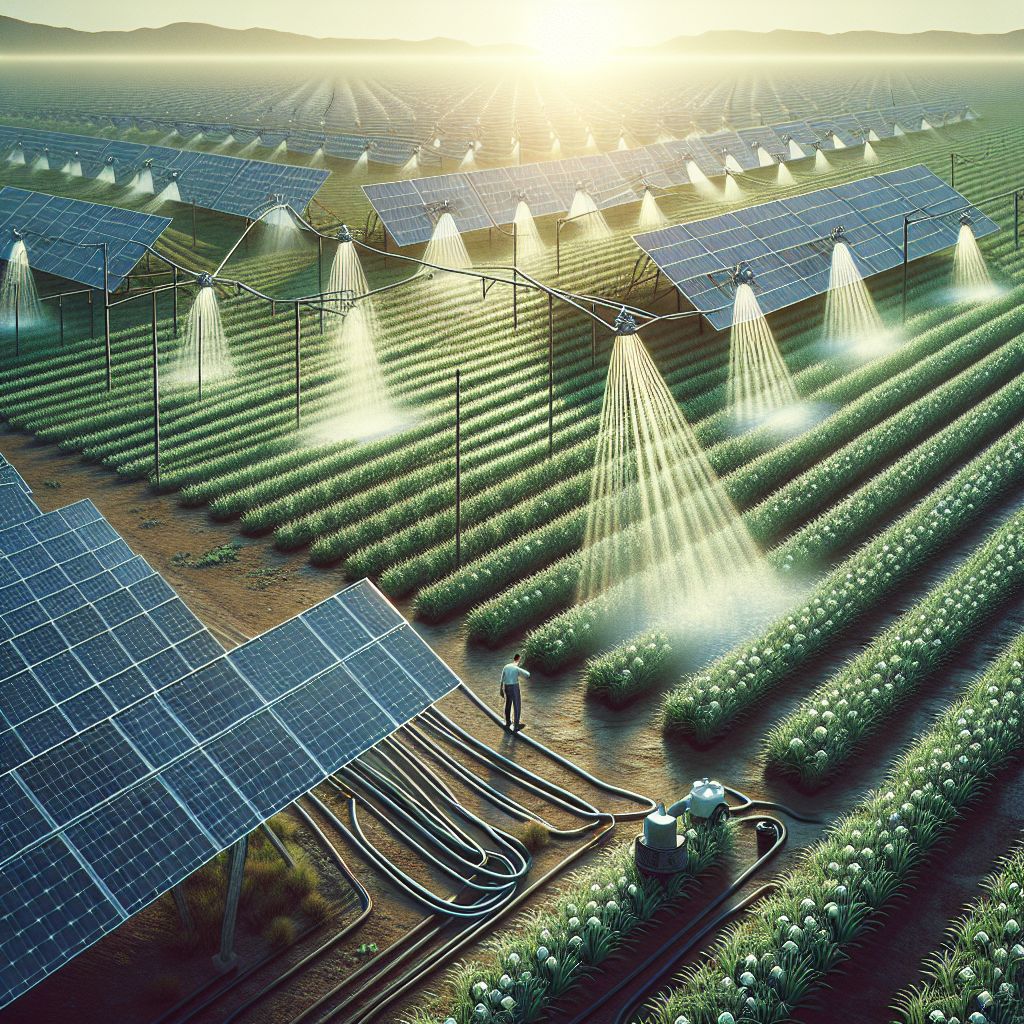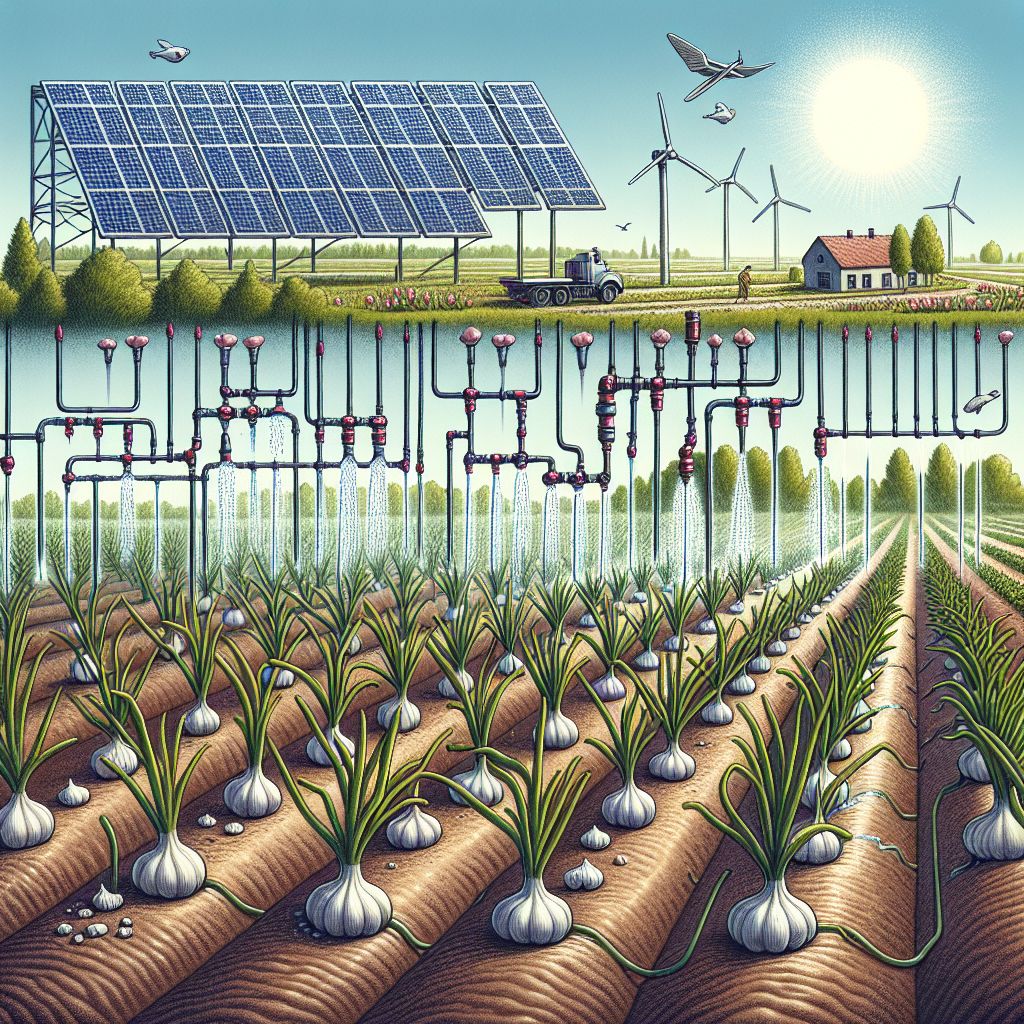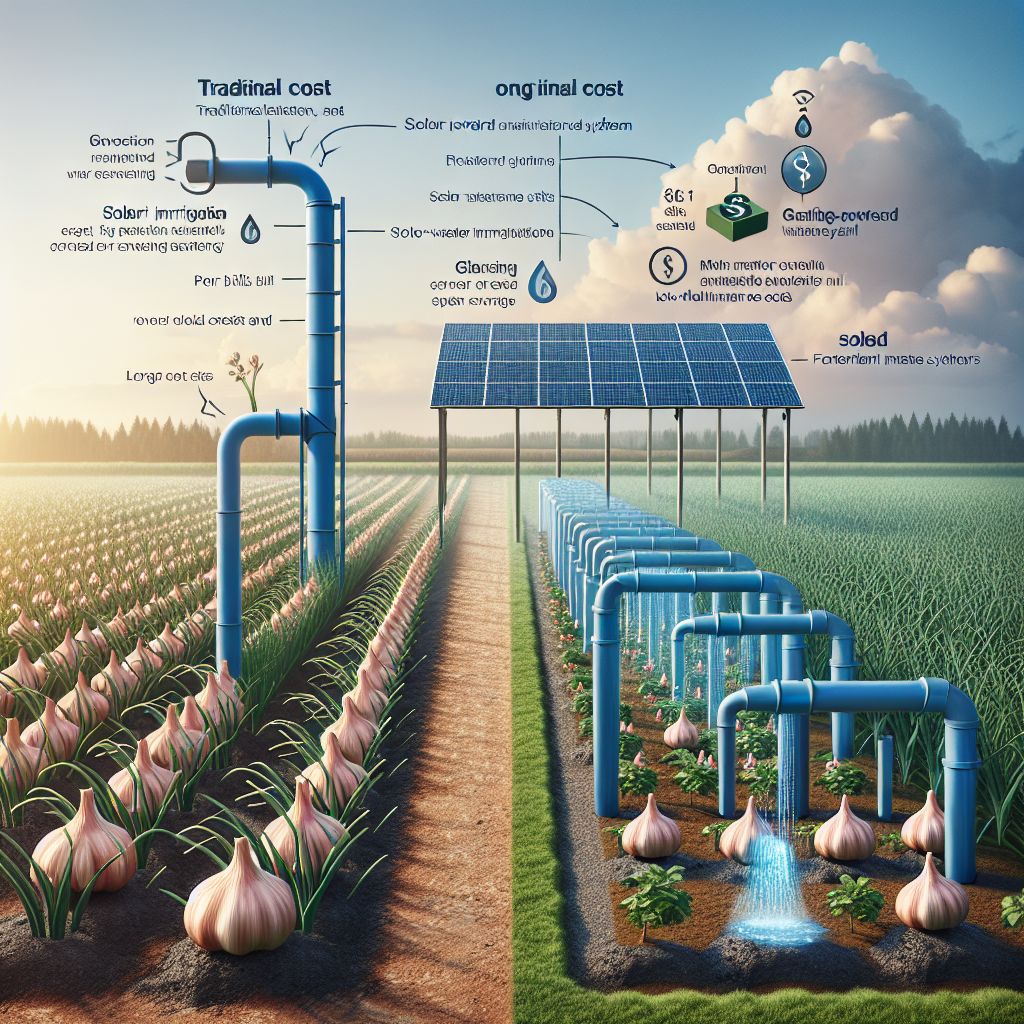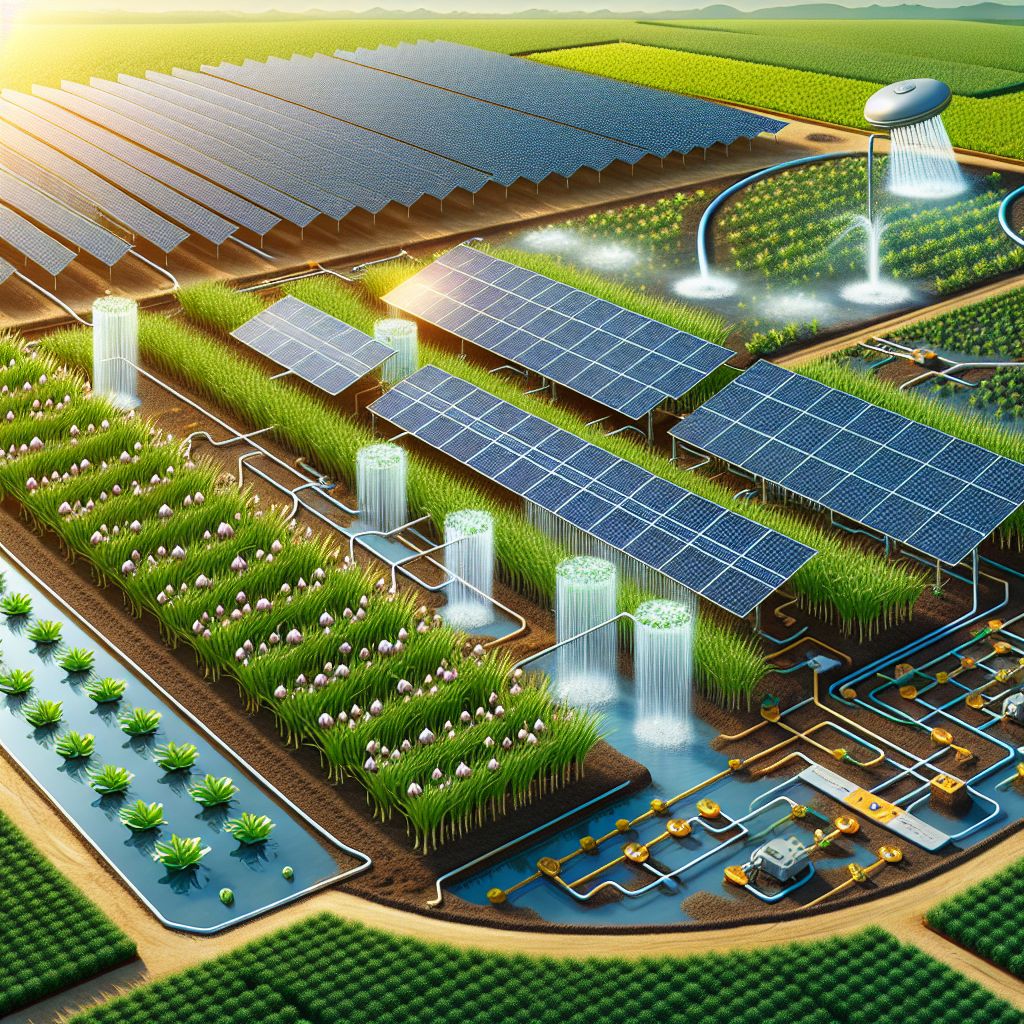
Looking ahead to the future of farming, it’s evident that sustainable practices are more than just helpful—they’re necessary. One of the most exciting developments in this area is the combination of solar power and irrigation systems, particularly for high-value crops such as garlic. Garlic isn’t just a key ingredient in cuisines all over the world, but it can also be a highly profitable crop for farmers who perfect their growing methods. So, let’s explore why solar-powered irrigation is revolutionizing garlic farming.
Key Takeaways
Solar-powered irrigation systems utilize renewable energy, resulting in lower electricity costs and a reduced carbon footprint.
Drip irrigation, which is particularly efficient for garlic, can be effectively powered by solar panels.
Selecting the appropriate solar panels, such as monocrystalline, can improve the efficiency of the irrigation system.
Investing in a solar irrigation system can lead to long-term savings and improved water conservation.
Understanding the cost, maintenance, and benefits of solar irrigation can assist farmers in making informed decisions.
Why Combine Solar Panels with an Irrigation System
Envision a farm where the sun not only nurtures the crops but also powers the system that waters them. This is not a far-off dream but a reality that is available now. Solar panels can harness the sun’s energy and transform it into electricity, which can then be used to operate irrigation systems without the need for grid electricity or diesel generators.
Utilizing Renewable Energy Resources
Garlic farmers have always seen the sun as a reliable partner. By using solar energy, they are able to access a power source that is not only plentiful but also free following the initial setup costs. This means that after you have set up your solar panels, the energy needed to operate your irrigation pumps is free.
Decrease in Electric Bills for Watering
Electric bills can eat up a lot of a farm’s earnings, but solar power gives you a chance to fight back. By putting money into solar panels, you can greatly lower or even remove the costs tied to running your irrigation system. And with the specific watering requirements of garlic, this can mean big savings.
Boosting Farm Energy Efficiency
Efficiency is a crucial element in farming, and solar power certainly excels in this area. By powering your irrigation system with solar panels, you are tapping into a direct energy source with very little transmission loss. This means more energy is used to power your pumps and less is wasted in the process.
The Green Advantages of a Smaller Carbon Footprint
Each time you opt for solar energy instead of fossil fuels, you’re making a choice that helps the earth. Solar-powered irrigation systems lower greenhouse gas emissions, which fights against climate change and protects the environment for future generations.

The Different Irrigation Systems Used in Garlic Farming
Garlic needs a steady supply of water to grow well. However, too much water can be as harmful as too little. That’s why it’s important to choose the right irrigation system. Let’s look at the different systems and how they can be powered by the sun.
Drip Irrigation: A Personalized Approach to Watering
Think of drip irrigation as providing each of your garlic plants with its own water bottle. This tube-based system delivers water directly to the base of each plant, minimizing waste and ensuring that each clove receives exactly what it needs to grow to its full, flavorful potential. Here’s why it’s a top choice:
Accuracy: Precise control over water application, reducing water wastage.
Water preservation: Water is delivered directly to the roots, minimizing evaporation and runoff losses.
Production: Can increase garlic yield by 15-25% compared to flood irrigation.
Sprinkler Systems: Simulating Natural Rainfall
Sprinkler Irrigation system involves overhead sprinklers that distribute water over the crop. While not as efficient as drip, sprinklers are suitable for larger garlic fields. Proper sprinkler design with appropriate nozzle selection and lateral spacing (around 6m) is important to minimize water losses.
Furrow Irrigation: Traditional Water Channel Method
In this traditional method, water is allowed to flow through small parallel channels or furrows between the garlic rows. It is a less efficient method compared to drip or sprinklers but can be used where other systems are not feasible. It is also the easiest and cheapest system to run
Here is a table summarizing the pros and cons of different irrigation systems for growing garlic:
|
Irrigation System |
Pros |
Cons |
|---|---|---|
|
Drip Irrigation |
– Efficient water usage, minimizes evaporation and runoff. 1, 3, 4 |
– Initial installation can be expensive. 1, 3 |
|
Sprinkler/Overhead |
– Inexpensive to install. 1, 4 |
– Promotes foliar diseases on pepper plants. 1, 4 |
|
Furrow/Flood |
– Simple system, low installation cost. 1, 3 |
– Very high water usage. 1, 3 |
What is the best Irrigation System to use on a Garlic Farm
Drip irrigation is undoubtedly the best option for growing garlic on a farm due to its numerous advantages. By conserving water, reducing disease risk, enhancing nutrient efficiency, suppressing weeds, and increasing yield, drip irrigation optimizes garlic cultivation, resulting in higher profitability and sustainability for farmers. By embracing this innovative technology, garlic growers can achieve maximum productivity and ensure the production of high-quality garlic crops.
Now that we know what irrigation system you should use, let’s look at the solar panels now.

Solar Panel Options for Your Garlic Farm’s Irrigation System
There are a variety of solar panels you can choose from for your garlic farm’s irrigation system. Each type of solar panel has its own benefits, and the best one for you depends on your specific needs and budget. Here’s a breakdown of your options to help you decide.
Choosing the right solar panels is crucial. You need to make sure that the panels you choose can supply sufficient power to operate your irrigation system for the entire growing period. Additionally, you should take into account the weather in your region. Some panels work better in hot weather, while others are more efficient in cooler climates.
Another factor to consider is the space you have. While larger, more efficient panels may appear to be the best choice, if you have limited space, you may need to choose panels that have a better size-to-power ratio. Finally, think about the lifespan of the panels and the warranties provided by the manufacturers.
Let’s now take a closer look at the different kinds of solar panels and what they have to offer.
High-Efficiency Monocrystalline Solar Panels
When it comes to efficiency, monocrystalline solar panels are the top choice. They are made from a single, pure crystal structure, which allows them to generate more power per square foot than other types. This makes them perfect for farms that don’t have a lot of space but need a lot of power for irrigation.
Monocrystalline panels are a good option for garlic farmers who want to invest in a reliable system. They may be more expensive initially, but they are more durable and efficient, which can lead to more savings over time. These panels also usually come with a 25-year warranty and have a longer lifespan.
Furthermore, they work well in low-light conditions, which is a plus for early morning or late afternoon work—times when garlic plants can use a little watering.
Polycrystalline Solar Panels: Budget-Friendly and Flexible
Polycrystalline solar panels are constructed from numerous silicon crystals, which makes them a bit less efficient than monocrystalline panels. However, they are less expensive, which can make them a more feasible choice for many farmers.
Flexible Installation Options with Thin-Film Solar Panels
Thin-film solar panels are not only lightweight and flexible, but they also provide unique installation options that are especially beneficial for farms with unconventional layouts. They can be installed on various surfaces, even those that are typically unsuitable for heavier traditional panels.
Thin-film panels, while not as efficient per square foot, are an excellent choice for larger areas where space is not an issue due to their adaptability. They also tend to perform better in high temperatures and are less affected by shading, making them ideal for farms in hotter climates. For those interested in sustainable farming practices, exploring solar irrigation system components can be a valuable step towards efficiency.
For example, a garlic farm in an area with high summer temperatures could benefit from thin-film solar panels. These panels would maintain a more consistent output during peak heat times, ensuring the irrigation system receives a steady flow of power.
Right below is a table looking at all the different solar panel options:
|
Solar Panel Type |
Efficiency Range |
Advantages |
Disadvantages |
|---|---|---|---|
|
Monocrystalline |
17-22% |
Highest efficiency, space-saving, long lifespan. 2 | |
|
Polycrystalline |
15-17% |
Lower efficiency, requires more space. 2 | |
|
Thin-Film |
10-13% |
Lightweight, flexible, good temperature coefficient. 2 |
Lowest efficiency, requires large area. 2 |
|
Portable Solar Panel Systems |
Varies based on panel type |
Designed for irrigation needs, easy to move and relocate. 1, 3 | |
|
Hybrid Solar Panels |
Varies based on components |
Can combine solar with other energy sources like wind, increased reliability. 4 |
More complex system, higher cost. 4 |
Monocrystalline panels provide the highest efficiency in a compact area but at a higher upfront cost (2, 3). Polycrystalline panels offer a balance of efficiency and cost (2, 3). Thin-film panels have lower efficiency but perform better in high temperatures (2). Portable solar panel irrigation systems allow flexibility in placement and relocation as needed (1). Hybrid systems increase reliability by combining solar with other renewable sources but add complexity (4). The optimal choice depends on factors like available space, budget, local climate conditions, and specific irrigation requirements for the garlic.
Choosing the Best Solar Panel for a Garlic Farm
The best solar panel for a garlic farm ultimately depends on the farm’s specific needs. If budget and space are limited, monocrystalline panels offer the highest efficiency and are a great choice. Polycrystalline panels are more cost-effective and may be more suitable for farms just starting with solar. Thin-film panels offer the most flexibility and are ideal for farms with ample space and a variety of installation surfaces.
By evaluating the layout of your farm, the climate, and your budget, you can determine the best solar panel for your garlic irrigation requirements.

Comparing the Cost and Efficiency of Traditional and Solar Irrigation Systems in Garlic Farming
When thinking about making the switch to a solar-powered irrigation system for your garlic farm, it’s important to consider the initial costs and the potential for improved efficiency and long-term savings. While traditional irrigation systems may be cheaper to install, they can end up costing more in the long run due to ongoing energy costs and water usage.
While solar irrigation systems might need a bigger initial outlay, they can offer substantial savings on power bills and an eco-friendlier water supply. Furthermore, these systems often have lower upkeep costs and can boost the overall efficiency of garlic farming.
This table compare the pros and cons of conventional irrigation systems and solar-powered irrigation systems:
|
Aspect |
Conventional Irrigation System |
Solar-Powered Irrigation System |
|---|---|---|
|
Pros |
No ongoing energy costs, uses free solar power. 5 | |
|
Simple installation and maintenance. 1 |
Environmentally friendly, reduces carbon footprint. 3 | |
|
Reliable water supply even during power outages. 5 | ||
|
Long lifespan of solar panels (25-30 years). 5 | ||
|
Cons | ||
|
Susceptible to power outages. 5 |
Requires some technical knowledge for installation/maintenance. 3, 4 | |
|
Environmental impact from energy use. 3 |
Risk of over-abstraction of groundwater if not managed properly. 3, 4 | |
|
Potential for water waste/inefficiency. 1 |
Upfront Costs and Long-Term Savings
While the initial price tag for a solar-powered irrigation system, including the cost of solar panels, batteries for storage, and the irrigation infrastructure, can run from a few thousand to tens of thousands of dollars, the investment is offset by the reduction in monthly utility bills and potential tax incentives and rebates.
In addition, solar panels have a long life span, often exceeding 25 years, and require little maintenance, which means that the system will continue to save money long after the initial investment has been recouped.
Examining Water Consumption and Preservation
Water is an invaluable resource, and preserving it is crucial for sustainable agriculture. Solar-powered drip irrigation systems are especially beneficial for garlic farming because they deliver water straight to the plant’s roots, decreasing evaporation and runoff. This focused watering method not only saves water but also lowers the likelihood of fungal diseases that can result from overwatering.
Garlic farmers can strike a balance between nurturing their crops and conserving water by marrying solar power and efficient irrigation. This leads to a farming operation that is not only more sustainable and cost-effective but also beneficial to both the farmer and the environment.

Conclusion: What is the Best Combination of Solar Panels and Irrigation system to be Most Efficient on a Garlic Farm
The ideal combination of solar panels and irrigation systems for a garlic farm depends on several factors, including the location of the farm, the climate, the size of the farm, and the budget of the farmer. Monocrystalline solar panels in combination with a drip irrigation system are highly efficient for smaller farms or those with a larger budget. Polycrystalline panels are a cost-effective alternative for farms that are new to solar power. For larger farms or those with a variety of landscapes, thin-film panels offer the most flexibility in installation and can still provide the necessary power for efficient irrigation.
Solar-powered irrigation shines in its ability to deliver water straight to the roots of plants, reducing water waste and energy use. When selecting the best system, it’s key to weigh the long-term savings in energy costs, the benefits to water conservation, and the potential for increased garlic yield and quality. Choosing solar-powered irrigation is not just a financial decision, but a dedication to sustainable farming practices that can pay off for years to come.
Is it a Good Idea for a Farmer to Upgrade His Irrigation System to Solar Powered?
Switching to a solar-powered irrigation system is an investment that can have many benefits for farmers. The decrease in ongoing energy expenses, the dependability of a renewable energy source, and the environmental benefits make it an attractive option. Even though the upfront cost may seem high, the long-term savings and potential for increased crop yields make it a good investment. Also, as the global market increasingly values sustainable practices, using solar irrigation can also improve the marketability of a farm’s produce.
Frequently Asked Questions
How does solar irrigation help conserve water?
When paired with drip irrigation systems, solar irrigation can help conserve water by delivering it directly to the roots of the plant. This method reduces evaporation and runoff, so that all water is used efficiently. Additionally, solar irrigation systems can be fitted with sensors and timers to tailor watering schedules to the specific needs of the garlic plants, further improving water conservation.
For instance, a garlic farm that made the switch to solar-powered drip irrigation saw a 30% decrease in water usage compared to traditional overhead sprinkler systems, showing a substantial saving in water.
Is it possible for any farm to use solar-powered irrigation?
While most farms are able to use solar-powered irrigation, there are certain factors that need to be taken into account, such as the geographic location, exposure to sunlight, and the topography of the land. Farms that are located in regions with plenty of sunlight are the best candidates for solar irrigation. It’s also crucial to have a clear understanding of the irrigation needs of the farm in order to design a system that can be effectively powered by solar energy.
How long does a solar-powered irrigation system last?
A solar-powered irrigation system can last a variable amount of time, but generally, the solar panels themselves are expected to last about 25 to 30 years. The other parts of the system, such as the pumps and the irrigation infrastructure, might not last as long and will probably need regular maintenance or replacement.
Does the government offer incentives for solar irrigation use?
Several governments provide incentives for the use of renewable energy technologies, such as solar irrigation systems. These incentives can come in the form of tax credits, rebates, and grants, which can greatly reduce the initial costs of investment. Before switching to solar irrigation, farmers should investigate the specific incentives available in their area.







Leave a Reply